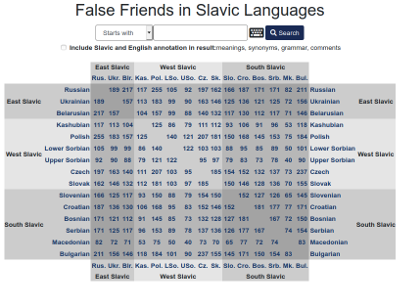The Portal hosts a new database: "False Friends in Slavic Languages."
The goal with the database is to provide an easy-to-use access to information on interlingual interferences in the Slavic languages. As one will see, there are many similar words among the Slavic languages which do not necessarily have the same semantics (or even, in some cases, have merely opposite meaning).
This kind of relation is often referred to as false friends ('faux amis') between two languages:
In linguistics, the informal term false friends refers to pairs of words in two languages (or in two dialects of the same language) that look and/or sound the same but have different meanings. Also known as false (or deceptive) cognates.
The term false friends (in French, faux amis) was coined by Maxime Koessler and Jules Derocquigny in Les faux amis, ou, les trahisons du vocabulaire anglais (False Friends, or, the Treacheries of English Vocabulary), 1928.
The database is especially useful to prevent to mistranslation and might be of interest to anybody who deals with more than one Slavic language.

Most of the linguistic information is presented in the articles on individual terms for each language. In an article, the particular term is listed with its meanings, followed by similar words and their meanings in other Slavic languages. Every article is rendered with a semasiological map and a matrix of word forms and meanings.
There are two approaches to find the needed information: One is to use the search enginge to find a term or by searching the headwords, meaning descriptions, synonyms, grammatical annotation and comments. The other approach is to use the table shown on the screenshot in order to browse the monolingual or bilingual word lists.
Go to the database False Friends in Slavic Languages

